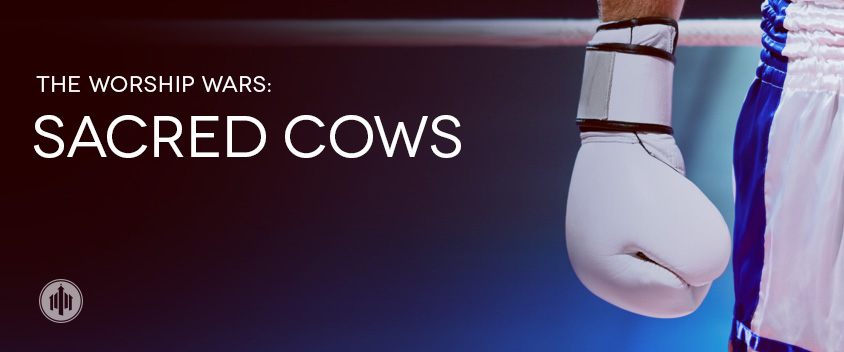
In continuing the Worship Wars series, we’ll take a look at something probably all of us have had the distinct pleasure pain of confronting… sacred cows. Within any organization, there are bound to be a few things that “cannot be changed.” Maybe it’s because it’s the “way it has always been,” or something similar. These issues, our “cows,” have gotten fat, grazing in their single spot and never being forced to move. Instead, the animals, if you will, have grown to excessive size due to how sedentary they have become.
The cows themselves range a wide (no pun intended) swath of values as varied as whether or not the choir is robed, if there is an American flag present on stage, if the congregation sees a grand piano instead of an upright, or heaven help us all, the dreaded electronic keyboard. At times it can be confusing as to just why something may be a sacred cow anyway. I heard a story once told by a well-respected preacher from Kentucky about one such sacred cow.
Wayne Smith recalls a time when, as a church leadership, they decided to go about communion service differently. The church, being fairly conservative, had a table sitting in the front with the elements on it, covered in a piece of linen cloth. You see, for some time the deacons of the church would walk forward solemnly in two rows until they reached the front pew. When they got there, the gentlemen stopped and bowed their heads. Two deacons would then walk forward and remove the linen, folding it in a manner that resembles how soldiers fold flags of American servicemen at a funeral. Mr. Smith speaks of it as being a highly dignified affair, which also consumed copious amounts of time within their service. So, they decided to change it. No more linens, no more table up front, no deacon parade. Just service from the back forward.
They didn’t mean to start a war, but one broke out. Members and attendees were upset with “removing the seriousness” of communion from the moment. Statements in that manner began to fly. Until, that is, Wayne Smith stood up to preach one morning and answered the venomous critiques. What was a sacred cow to some was merely a cheap and expedient way to fix a problem many years prior. The church roof had a leak, and any time it rained, there would be a steady drip from the ceiling that would land on the communion elements spread across the table. He became so distracted by it, that one week he asked for a piece of cloth to be placed over the elements, just so it didn’t make a lot of noise and the communion elements would stay dry. Long after the roof was fixed, the process remained in place. And when it came time to finally shoot this sacred cow, the herd wanted to stampede.
So how do we keep that from happening? Here are a few things consider:
1. Is it a hill worth dying on?
When we go after sacred cows, we are inevitably charging up a long and well-defended hill. There will be casualties. Either the cow goes down, or we do. Is it worth it? Some battles we try to wage within the church just aren’t worth the cost of the damage. Is it annoying to wear, or see, choir robes? To some yes. To others no. Is it really a matter of salvation or worthy of devoting time and energy to? That is the question we must ask.
2. How the process is started determines how the process ends.
I’ve heard someone say, “You’ll never get a better output than what you input.” And while they were speaking from an aspect of sound reinforcement, the same is true of our dealings within the church.
If we expect respect and a listening ear, we must give respect and a listening ear. Dialogue. While each instance is different, at times the dialogue can lead to amazing compromise. Which is a beautiful picture of unity within the church.
3. What’s the best way to make hamburger?
While I mean this to be somewhat humorous, there is real implication lying within. Cows don’t find slaughter randomly, there is a purpose. The nourishment provided to our particular holy bovine must be redirected to nourish something else. Shooting a sacred cow just because we don’t like it will never result in something better.
Andy Stanley states in his book, Deep and Wide, that “everything you do has an expiration date.” And let’s face it; we have sacred cows because they have lived well past their intended purpose. Make sure that one sacred cow doesn’t just give way to another.
4. How do we honor what came before while reaching towards what lies ahead?
I wish I had the complete answer to that. The only certainty I know in regards to this question, is that it depends largely on the context within which you and I serve.
The only real way I know of completing this task, is to reach back to dialogue. Ask those keepers of fine bovine pastures why they are so tied to it. It is from this place that you might find a solid reason as to why this cow has avoided slaughter for so long. Yet, usually, it is through the reasoning of longevity that we find a way to replace the cow with something even more beneficial to the body.
But for the benefit of the body, whatever you do, DO NOT move the American flag.

